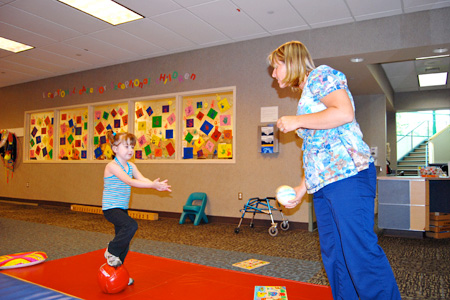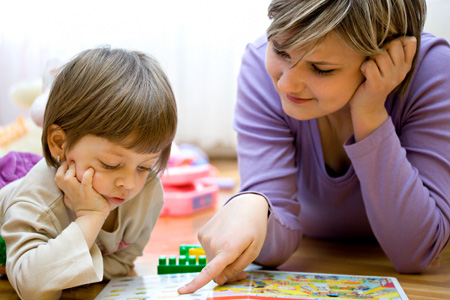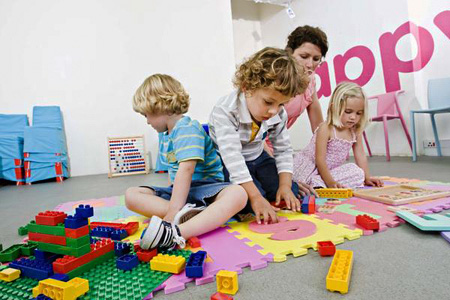Services

We offer a variety of classes to meet the training requirements of child care providers as well as other industry specific guidelines with the help of a therapist. Our therapists are dedicated to providing personal and caring services for our patients. Children are matched with a therapist who fits their individual needs, thus developing relationships that enhance the consistency and effectiveness of the therapy we provide. We provide continuous support and encouragement in their education, and providing them with a fun and supportive environment is key to our success.
Occupational Therapy

What is OT?
Occupational Therapy is concerned with a person’s ability to participate in daily life activities or “occupations”, which include self-care, work and play.
A child’s job of growing into adulthood involves continual adaptation to the demands of the environment, as well as the assimilation of the various opportunities he / she encounters. The dynamic nature of this interaction is determined by the child’s internal clock of maturation as the child adapts to his/her changing environment. Occupational Therapy practice is based on an understanding of the interactions between children, their activities (or occupations), and their environment.
Occupational therapist (OT) empowers individuals to participate in their occupations / activities of daily living to their fullest potential. For children, their occupation is play and learning. Using sensory-integration techniques in therapy, children learn to integrate their senses, improve motor control, body awareness and organization skills and transfer these skills to their home and school environments. We also work in close liaison with other professionals like speech & language therapist, educational psychologist and teachers.
Who are the children who will benefit from an Occupational Therapy Intervention?
Children who have difficulties with:
- Gross motor skills
- Fine motor skills
- Sensory integration abilities (modulation and discrimination ability with sensory input)
- Motor planning(Praxis)
- Visual motor integration
- Visual perception skills
- Co-ordination
- Oral Motor (oral defensiveness and motor planning issues)
These difficulties might result in the following problems:
- Clumsiness
- Handwriting
- Sitting still in class
- Short attention span
- Hyperactivity due to sensory seeking behaviours
- Balancing responses
- Manipulation of objects and tools
- Independence in self care tasks
- Performance in physical education
- Feeding issues
Occupational Therapy Services include:
Assessment (screening or in-depth)
- Standardised assessments
- Informal assessment which includes clinical observations
The Assessment process allows the Occupational Therapist to:
- Determine the core cause of the difficulty
- Set Intervention Goals
- Set a baseline to determine the child’s abilities before intervention
Intervention (individual or group sessions)
- Use of child’s strength to compensate for his weaknesses
- Target the root causes of observed behaviours
- Modify the child’s environment to match his abilities
- Teach the child coping strategies
- Direct training of targeted tasks
- Advise parents and teachers on appropriate management techniques of the child
- Sensory Integration Intervention that might include a personalized “sensory diet”
Occupational Therapy Intervention is child directed and is incorporating play as motivation for learning experience. During the Occupational Therapy session, it is important to design suitable challenges for the child to provide opportunities for learning that will promote his/her sense of success. The fun experiences provided in the sessions motivate the child to develop skills to adapt more efficiently to his/her environment.
All this should promote positive emotions that will help the child to have better control over his/her life, socialize better and improve the attitude towards learning.
Neuro Developmental Therapy

Neuro-Developmental Treatment is a hands-on treatment approach used by physical therapists, occupational therapists and speech-language pathologists. The approach was developed to enhance the function of adults and children who have difficulties in controlling movement resulting from neurological challenges such as stroke and head injury, aims to promote development of the nervous system and the inhibition of primitive reflexes.
Speech Therapy

Speech is the verbal means of communication. This has three components- voice, articulation and fluency. Use of the vocal cords with a controlled breathing pattern produces sound called voice. Problems in voice may be due to many reasons like infections of throat, misuse/overuse of the voice resulting in hoarseness of voice or it can be loss of voice as in stroke, paralysis of the vocal cord of one side. The way we make different speech sounds using our tongue, lips, nose or throat is called as the process of articulation. Any problems in this like cleft palate, problems in tongue/lip movement or even overcrowding of teeth can result in articulation disorders in addition to disorders of the cerebellum which results in dysarthria(difficulty in speaking as if drunk). The rate and rhythm in which we speak constitute the fluency. Difficulties in this may result in stammering/stuttering.
SPEECH DISORDER VS LANGUAGE DISORDERS:
When a person cannot understand what others tell (receptive), then he is said to have a receptive language problem; when not able to tell (express out what he wants to say/ express) is called expressive language problem.
A problem in a person who is unable to produce speech sounds correctly or fluently, or has problems with his or her voice is called a speech disorder.
Both can exist together in one person/ separately. The use of social language in appropriate situations appropriately is called Pragmatics. Pragmatics has 3 major communication skills.
How to use language for different purposes, like
- Greeting (e.g., Namasthae, Good Morning, Hello, Goodbye)
- Informing (e.g., I'm going to sleep)
- Promising (e.g., I will get you a chocolate)
- Direct training of targeted tasks
- Requesting (e.g., give me a chocolate, please)
How to change language according to the needs of a listener or situation, like
- Talking differently to a baby (baby talk) than to an adult
- Telling background information to an unfamiliar person
- Speaking differently in a classroom than on a playground
Following rules for conversations and storytelling, such as
- Taking turns in conversation
- Introducing topics of conversation
- Staying on topic
- Rephrasing when misunderstood
- How to use verbal and nonverbal signals
- How close to stand to someone when speaking
- How to use facial expressions and eye contact
Such a child/person will have –limited variability in conversation; disorganized storytelling skills; tells in appropriate words/ things during the conversation. This can cause considerable hardship to the child as other children may avoid talking to this child with a pragmatic disorder resulting in lower social acceptance as in disorders like autism.
The speech language pathologist works to assess and treat children with communication disabilities including delays or disorders in language (words and sentences), articulation (speech), and resonance and stuttering.
WHAT WE DO:
or articulation problems: Speech therapists use three different methods to teach children the correct production of problem sounds. The three different methods include: auditory training, visual training and tactile training. During auditory training the child listens to multiple correct productions of the target sound; Visual training involves visually showing the child how to position his/her tongue, lips, teeth and jaw and Tactile training focuses on teaching children to feel the correct tongue placement and movement necessary to produce the correct sound.
Step: 1 - Deciding where to begin. Speech therapist usually uses standardized articulation tests/screeners to determine the sounds Child/Patient struggles.
Step: 2 - Then our speech therapist considers the most stimulable sounds (what sounds we can elicit from the student/client without much difficulty), and any patterns we may see among the speech errors that were produced when setting goals.
Step: 3 - Once the speech goals are assessed and set, we use an articulation goal tracking sheet to track your child/clients’ progress and to keep track of the goals to work next. Parents can always ask for our goal tracker to see the progress from our reception.
Special Education

Special education or special needs education is the practice of educating students with special needs in a way that addresses their individual differences and needs. Our Special Educator focuses to meet the individualized educational, cognitive, behavioural and esteem needs of children's using various teaching strategies. eds (SEN) that affect a child’s ability to learn can include their:
- Behaviour or ability to socialise, e.g. not being able to make friends
- Reading and writing, e.g. they have dyslexia
- Ability to understand things
- Concentration levels, e.g. they have Attention Deficit Hyperactivity Disorder
- Physical needs or impairments
